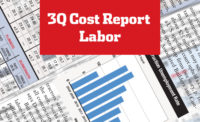Construction executives continue to see steady compensation increases following an improved 2015 construction market. Average increases in salaries for executives rose 4.1% in 2015, up from 3.8% in 2014, according to the 2016 Executive Compensation Survey for Contractors, published by Personal Administration Services, Saline, Mich. Increases topped 4% for the first time since before the recession but remain below 2007’s 5.4% increase.
Construction executives could see similar increases in 2016 and possibly 2017, says Jeff Robinson, president of PAS.
Although companies forecast, on average, a 3.6% salary increase in 2016, Robinson notes that companies typically underestimate such increases. He expects average increases will be above 4% in 2016 and anticipates similar results in 2017. “I’m feeling pretty confident that, in 2017, we’ll see the same,” he says. “I don’t see it letting up in the next two years.”
Company presidents saw the highest average total (base salary and bonus) compensation, increasing by 11% in the 2016 survey ($425,706) from the 2015 survey ($381,986). Most other positions increased between 5% and 7% in total compensation, Robinson said.
Higher bonuses significantly contribute to the rise in executive pay. Notably, the number of companies giving bonuses rose last year. For example, 17% more companies gave bonuses at the executive vice president and senior vice president levels in 2015 compared to 2014, according to the survey. “That’s very encouraging news,” Robinson adds. “That says that we’re getting back to the norm [for compensation].”
Dan Pauletich, senior managing director of Specialty Consultants, Pittsburgh, notes that, as profitability improves for many construction firms, bonuses represent a significant component of executive compensation packages.
“Coming out of the recession, contractors were taking work at lower margins,” Pauletich says. “Since 2013, we’ve seen margins improve—hence, better profitability and the payoff in bonuses.”
Companies are leveraging improved bonuses to help retain top talent. “I hear people say, ‘I have a $75,000 bonus due here before I can look around at other opportunities.’ ”
Pauletich also has seen bonus opportunities expand within companies. Some firms with both developer and construction capabilities are offering carried interest incentives to construction executives, enabling them an opportunity to share in the profitability of a project. “Historically, carried interest had only been for the rainmakers,” he says. “That’s indicative of the demand out there.”
Some companies are adding education and training opportunities to compensation packages for potential future leaders, Pauletich says. “There’s a pretty good gap between the aging workforce at the executive level and the next level” of management, he notes. “I’ve seen companies that [in the past] may have turned a blind eye toward education and building leaders from within … that have recently embraced the idea of paying for education and training in developing true career paths for employees.”
Although average executive compensation is up nationwide, there are some variations by region and market sector. Robinson notes that most regions remain competitive, with pockets of depressed activity. “In California, you see some areas with 6% increase, but 100 miles away the average is 2%.”
Instability in the heavy industrial and energy markets has led to a flattening of wages in regions where those sectors are prominent, Robinson observes.
Michael Ketner of executive search firm Michael L. Ketner & Associates, Pittsburgh, says he sees a broad spectrum of increases. “Where markets are booming, we see substantial increases between base and bonuses that are between 6% to 10%,” he says. “In areas of less prosperity, it’s 2% to 3%.”
Ketner says executive opportunities have been particularly robust in major metro markets, such as New York City, Washington, D.C., and Dallas.
In some cases, companies are including relocation incentives to attract top executive talent, such as paying off a house or covering moving costs. “Companies do what they need to make [new hires] comfortable coming in,” Ketner says.



Post a comment to this article
Report Abusive Comment